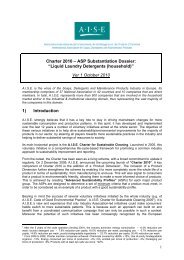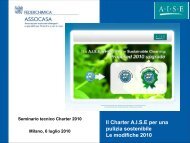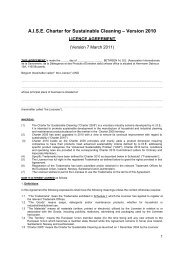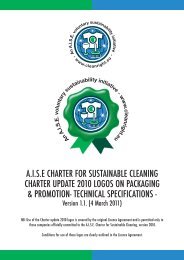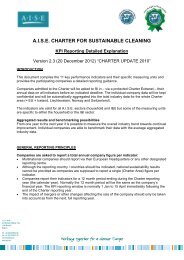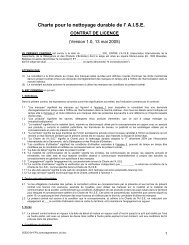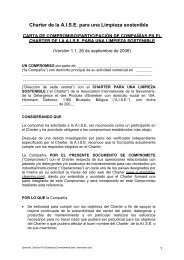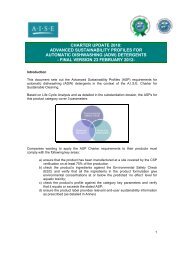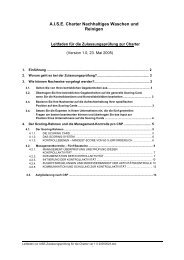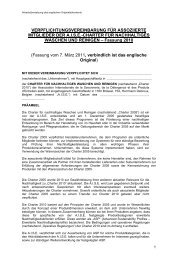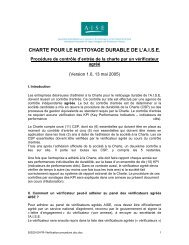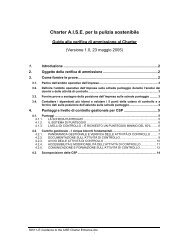1. ASP Criteria - Sustainable Cleaning
1. ASP Criteria - Sustainable Cleaning
1. ASP Criteria - Sustainable Cleaning
You also want an ePaper? Increase the reach of your titles
YUMPU automatically turns print PDFs into web optimized ePapers that Google loves.
CHARTER 2010:<br />
ADVANCED SUSTAINABILITY PROFILES FOR<br />
HOUSEHOLD FABRIC CONDITIONERS<br />
- 10 FEBRUARY 2011 -<br />
Introduction<br />
This document sets out the proposed Advanced Sustainability Profiles (<strong>ASP</strong>)<br />
requirements for fabric conditioners in the context of the A.I.S.E. Charter for <strong>Sustainable</strong><br />
<strong>Cleaning</strong> 2010.<br />
Based on Life Cycle Analysis and as detailed in the substantiation dossier, the <strong>ASP</strong> for<br />
this product category would cover 3 parameters:<br />
Companies wanting to apply the <strong>ASP</strong> Charter 2010 requirements to their products must<br />
comply with the following key areas detailed in this document:<br />
a) ensure that the product has been manufactured at a site covered by the CSP<br />
verification on at least 75% of the production<br />
b) check the product’s profile against the category key LCA Parameters and<br />
verify that it equals or exceeds the stated Advanced Sustainability Profile;<br />
c) check the product’s ingredients against the Environmental Safety Check and<br />
verify that all the ingredients in the product formulation give environmental<br />
concentrations at or below the predicted ‘no effect’ level for aquatic toxicity (;<br />
d) ensure the product label provides relevant end-user sustainability information<br />
as prescribed for each category by Charter 2010 (as detailed in Annex)
Timing<br />
<br />
<br />
<br />
<br />
<br />
From 18 Dec. 2009 till 27 Jan 2010: Internal and external consultations on<br />
<strong>ASP</strong>s for laundry detergent powders and liquids and fabric conditioners<br />
By 1 July 2010: Finalisation of <strong>ASP</strong> packages<br />
By 1 July 2010: Availability of <strong>ASP</strong>s to the industry<br />
1 July 2010 till 30 June 2011: Preparation period for implementation of <strong>ASP</strong>s<br />
As from 1 July 2011: Activation – products complying with Charter 2010/<strong>ASP</strong><br />
requirements for fabric conditioners can start to appear on shelves with <strong>ASP</strong><br />
logo<br />
<strong>ASP</strong> criteria<br />
<strong>Criteria</strong> for Fabric Conditioners<br />
The following requirements in each of these domains (i.e. product formulation, packaging<br />
and end-use information) should be fulfilled in order to reach Advanced Sustainability<br />
Profiles (<strong>ASP</strong>) status.<br />
Product formulation<br />
Pass successfully Environmental Safety Check (ESC)*<br />
on all ingredients<br />
Packaging weight per job<br />
Packaging re-cycled content<br />
End User Information<br />
AND<br />
Dosage ml/job:<br />
≤ 35ml<br />
Total (primary + secondary but excluding tertiary)<br />
packaging g/job: ≤ 4g<br />
Primary packaging: No minimum, but any re-cycled<br />
plastic content is excluded from calculation of packaging<br />
weight per job<br />
Secondary packaging: Board: ≥ 60%<br />
End-user info on-pack:<br />
Washright panel or alternative (see Annex)<br />
Performance<br />
Evidence has to be provided (in case of external<br />
verification organised by A.I.S.E.) that the product has<br />
been performance tested and reached a level<br />
acceptable to consumers consistent with claims made.<br />
*All details on the ESC can be found on the Charter technical website:<br />
www.sustainable-cleaning.com<br />
Clarifications/Definitions:<br />
Total dosage/job: For fabric conditioners the lowest recommended dosage in ml for a normal load<br />
in a 4-5 kg washing machine should be considered. If recommended dosages for the fabric<br />
conditioner vary with water hardness, the lowest recommended dosage for water of medium<br />
hardness, corresponding to 2,5 millimoles CaCO3/l should be used, again for a normal load in a<br />
4-5 kg washing machine. A normal load here is defined as a full load of cotton or mixed<br />
cotton/synthetic fabrics<br />
Packaging weight per job: Total (primary + secondary) packaging (g/job) - based on the volume<br />
weighted average for all SKUs of one brand variant with the same formulation per country.<br />
2
Variants of the brand which do not pass all other <strong>ASP</strong> category tests and/or are not intended to<br />
carry the <strong>ASP</strong> logo must be excluded from the calculation. Dosage devices – apart from closures<br />
– are not to be considered as packaging.<br />
Primary/secondary/tertiary packaging: following definitions from the European Parliament and<br />
Council Directive 94/62/EC of 20 December 1994 on packaging and packaging waste:<br />
- primary packaging, i. e. packaging conceived so as to constitute a sales unit to the<br />
final user or consumer at the point of purchase;<br />
- secondary packaging, i. e. packaging conceived so as to constitute at the point of<br />
purchase a grouping of a certain number of sales units whether the latter is sold as<br />
such to the final user or consumer or whether it serves only as a means to replenish<br />
the shelves at the point of sale; it can be removed from the product without affecting<br />
its characteristics; SRB (shelf ready box) and AB (American box) are to be<br />
considered as secondary packaging.<br />
- tertiary packaging, i. e. packaging conceived so as to facilitate handling and transport<br />
of a number of sales units or grouped packagings in order to prevent physical<br />
handling and transport damage.<br />
Note: Packaging which functions both as secondary (case) and tertiary (transportation unit)<br />
packaging, intended to function as an in-store free-standing floor display unit, is regarded as<br />
tertiary packaging for the purpose of this definition.<br />
Packaging re-cycled content: in countries where re-cycled board is not available and a use of it<br />
would be a disadvantage for sustainable reasons, the use of re-cycled board is not required.<br />
Re-cycled: waste re-cycled after use<br />
3
ANNEX: END USER INFORMATION<br />
The following options are possible in order to fulfill the <strong>ASP</strong> criteria on End User<br />
Information for fabric conditioners. Professional graphic files and guidelines are<br />
available on www.aise.eu/end_user_info<br />
<strong>1.</strong> Washright Panel with sentences<br />
Option a)<br />
Option b)<br />
2. ‘Silent’ Washright Panel<br />
Option a)<br />
Option b)<br />
4
Additional alternatives for fabric conditioners<br />
3. Sentence with tips and reference to Cleanright website<br />
Option a) Option b) Option c)<br />
Option d) Option e) Option f)<br />
5



